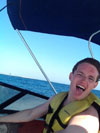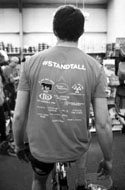|
|
|
|
Connor
 Connor is known as "The Boy" to his three older sisters and Mum. The family has always spent a lot of time together, and he always challenges us to random workouts and a good game of Scrabble! He only has to hear the kettle and shouts "Tea!" and we have made more cups than we can count.
Connor is known as "The Boy" to his three older sisters and Mum. The family has always spent a lot of time together, and he always challenges us to random workouts and a good game of Scrabble! He only has to hear the kettle and shouts "Tea!" and we have made more cups than we can count.
Anyone who knows Connor, knows he is always good-natured and injects a little bit of magic into the everyday with his enthusiasm for the world. Life is always punctuated by the sound of song when Connor is around. Even our many pets have always adored him.
His rugby career started in Earlston with the Blue Eagles and carried on through to Merchiston Castle School, which he attended on an academic scholarship. He thrived in the competitive and fitness-focussed environment, achieved excellent exam results and was involved in a multitude of extra-curricular activities and accomplishments. Connor earned a place to study Sports Science at Stirling University, but subsequently switched his course to Accounts & Business after deciding he wanted to set up and run his own gym and fitness centre to promote his personal brand of dedication to exercise and wellbeing.
Before taking up his place at university, Connor spent seven months in New Zealand and Hong Kong, working and touring, but made sure he was back in time for the birth of his first niece, Ava Grace.
Connor has always known what he wants to achieve, and has had a very clear plan of the life he wants for himself and his children one day. He had a clear journey mapped out and was prepared to work hard for it. There were always lists around the house of gym regimes and protein-rich foods, as well as exciting plans for the days ahead.
Connor's injury has put obstacles in this journey, but that boy is very much with us.
The Accident
On September 13, 2014, Connor, then 19, suffered a catastrophic injury to his cervical spinal cord whilst playing rugby. He dislocated his fifth and sixth vertebrae in his neck and became paralysed from the shoulders down. Connor was playing in an away match for the University of Stirling in a pre-season friendly against the Dundee team, Harris RFC.
He received first aid on the pitch and then at Ninewells Hospital, Dundee. However, Connor's injury required specialist treatment and he was transferred the following day, by a police escorted ambulance, to the Queen Elizabeth National Spinal Injuries Unit of the Southern General Hospital, Glasgow.
While there, Connor had to endure several torturous procedures in order to survive the next few days. Initially due to spinal shock, a reflex reaction by the damaged spinal cord to protect itself, Connor was only able to move his eyes and mouth. The vertebrae in his neck were displaced by over 50% from their normal positions, which was agonising for Connor and caused bleeding and compression of the spinal cord. The surgeons applied traction to his head in an attempt to separate the two vertebral bones. He had two screws drilled into his skull that held a metal cage around his head. This was attached to over 11lbs of weight pulling down towards the floor. A wide bore feeding tube was inserted in through his nostril, down the back of the throat and into his stomach to allow administration of liquid nutrition and large volumes of drugs. A 10-hour surgery followed, carried out by the neurosurgeon team, to remove the damaged ligaments, the pulped intervertebral disc and to reposition the bones. This was achieved with a titanium plate, a metal "De Puy" cage filled with bone shavings, a replacement plastic disc and eight screws. All of this stabilised the structure of the neck, but sadly the surgery could not reverse the extensive spinal cord damage.
The Campaign
 "Connor's Journey" was created while Connor was still in the acute ward of the hospital. His family established a website as a medium for fundraising to aid his rehabilitation and it was Connor himself who chose the fitting quote by Ralph Waldo Emerson: "Do not go where the path may lead, go instead where there is no path and leave a trail", and the motto "Stand Tall". The incredible support the campaign received was absolutely overwhelming and it is still ongoing. Donations and fund-raising sums have flooded in, really reflecting the close-knit community spirit of the rugby world at all levels, and the generosity of so many individuals who have been moved by Connor's strong character and his story.
"Connor's Journey" was created while Connor was still in the acute ward of the hospital. His family established a website as a medium for fundraising to aid his rehabilitation and it was Connor himself who chose the fitting quote by Ralph Waldo Emerson: "Do not go where the path may lead, go instead where there is no path and leave a trail", and the motto "Stand Tall". The incredible support the campaign received was absolutely overwhelming and it is still ongoing. Donations and fund-raising sums have flooded in, really reflecting the close-knit community spirit of the rugby world at all levels, and the generosity of so many individuals who have been moved by Connor's strong character and his story.
In the first week of the website going live, donations exceeded over £10,000 and reached an astonishing £65,000 by the New Year. Thereafter, a fresh £100,000 target was set and is well underway to being met. This is in order to help Connor achieve his developing aims which have evolved as his recovery has progressed, made possible thanks to the support which he has been honoured and humbled to receive.
Funds raised initially were used to make house adaptions that allowed him to leave hospital much earlier than expected, which in itself was a massive morale boost. The next step was an adapted transport vehicle enabling Connor to get out and about. Standard chairs have a lengthy application process, so rather than the long wait funds provided the opportunity to purchase a custom-made wheelchair just in time for the next stage of the journey: travelling to Project Walk in America, only three months post-injury.
Current Targets
Connor's attitude and knowledge regarding his condition and his own body has grown so much since last year. His objectives have continued to evolve and he has new targets for the coming year. The goal that underpins all his and his family's endeavours is for Connor to regain as much function as possible and live the life he wants to lead. Specifically this translates to the following:
• To finish and further equip his specially adapted gym
• Join a wheelchair rugby team, for which a specialist chair and kit will be needed
• Continue with his University degree
• Travel to Thailand in August, 2015, to undergo radical treatment for Spinal Cord Injury
The Next Step of the Journey - Thailand
Connor and his family have followed all research into spinal cord injury avidly since his injury. There are many exciting developments that will be able to help in the future and offer more of a chance of recovery compared to the often bleak prognosis that Spinal Cord Injury (SCI) patients face now. Connor is travelling to Bangkok, Thailand in August 2015, along with his sister Sarah, to take part in two very exciting components of SCI research, stem cell treatment and epidural cord stimulation.
This opportunity is not offering a cure but a fighting chance. Firstly the role of stem cells has long been considered as a potential method of helping the spinal cord repair itself and is being developed in centres all over the world. Stem cells differentiate into many different types of cells including neural/nerve cells, muscle fibres, retinal ganglion cells and hepatic cells, promote new blood vessels and increase blood supply to the injured/targeted area, They help modulate the immune system (re-duce inflammation or increase immune response accordingly), release growth factors and stimulate patient's own stem cells as well, which further promotes cellular differentiation.
The potential benefits of stem cells:
- improved motor functions
- improved sensations
- improved muscle mass, tone, spasms and strength
- improved bladder and bowel control
- improved sweat ability
- improved balance and co-ordination
- improvement in neuropathic pain
Secondly, the role of electrical stimulation directly to the spinal cord has been a very active area of research in recent years. There has been success with this method in the USA by Dr. Harkema via the Reeve Foundation and "The Big Idea" and many research centres globally, including the University of Aberdeen here in Scotland are using similar concepts. The stimulator is placed directly on the cord and an electrical current is passed through the nerves to activate them which is translated into voluntary movement and potentially improved control of autonomic functions. It requires intensive exercise by the patient to retrain the body to respond to these electrical impulses and draws on all the training Connor received in Project Walk.
Bangkok Better Being Hospital has been chosen by us for Connor for several reasons:- The stem cells are provided by Beike Biotechnology (www.beikebiotech.com) has a proven safety record and meets all international quality requirements and have vast experience in producing stem cells. Better Being Hospital (www.betterbeingthailand.com) is the first hospital in Asia to be deemed a Centre of Excellence as a Functional Medicine Centre: they approach the body as a whole and treat every aspect of an individual's health whilst trying to improve spinal function.
There have been several UK and US patients in a similar situation who have received stem cell treatment in Bangkok, with very promising results. The Better Being Hospital's medical team has extensive experience in the use of stem cells and in the surgical placement of the epidural stimulator. They have placed seven of the 11 stimulators used in the world to date.
Connor will be in Bangkok for 45 days to receive treatment and hone the next stage of his exercise regime in order to maximise the potential gains.
|
|



|
|
|